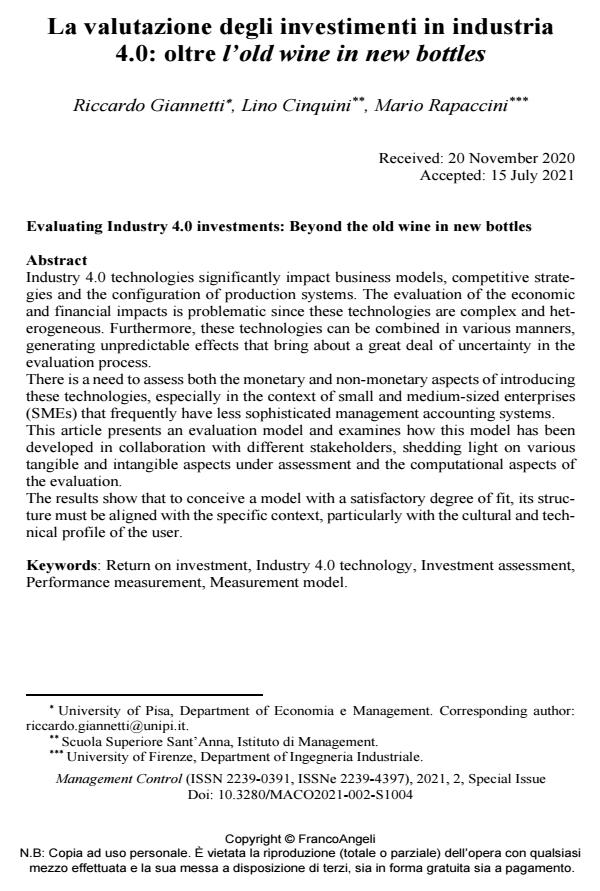Evaluating Industry 4.0 investments: Beyond the old wine in new bottles
Journal title MANAGEMENT CONTROL
Author/s Riccardo Giannetti, Lino Cinquini, Mario Rapaccini
Publishing Year 2021 Issue 2021/suppl. 2
Language Italian Pages 26 P. 65-90 File size 301 KB
DOI 10.3280/MACO2021-002-S1004
DOI is like a bar code for intellectual property: to have more infomation
click here
Below, you can see the article first page
If you want to buy this article in PDF format, you can do it, following the instructions to buy download credits

FrancoAngeli is member of Publishers International Linking Association, Inc (PILA), a not-for-profit association which run the CrossRef service enabling links to and from online scholarly content.
Industry 4.0 technologies significantly impact business models, competitive strategies and the configuration of production systems. The evaluation of the economic and financial impacts is problematic since these technologies are complex and heterogeneous. Furthermore, these technologies can be combined in various manners, generating unpredictable effects that bring about a great deal of uncertainty in the evaluation process. There is a need to assess both the monetary and non-monetary aspects of introducing these technologies, especially in the context of small and medium-sized enterprises (SMEs) that frequently have less sophisticated management accounting systems. This article presents an evaluation model and examines how this model has been developed in collaboration with different stakeholders, shedding light on various tangible and intangible aspects under assessment and the computational aspects of the evaluation. The results show that to conceive a model with a satisfactory degree of fit, its structure must be aligned with the specific context, particularly with the cultural and technical profile of the user.
- The impact of digitalisation on professional football clubs Fabio Nappo, Alessandra Lardo, Maria Teresa Bianchi, Federico Schimperna, in MANAGEMENT CONTROL 2/2023 pp.117
DOI: 10.3280/MACO2023-002006 - L'implementazione di tecnologie 4.0 nelle piccole imprese: analisi di un caso di successo Paolo Bogarelli, Nicola Castellano, in MANAGEMENT CONTROL 2/2023 pp.137
DOI: 10.3280/MACO2023-002007 - Management Control System in Smart and Sustainable Firms Domenica Lavorato, pp.137 (ISBN:978-3-031-81435-8)
Riccardo Giannetti, Lino Cinquini, Mario Rapaccini, La valutazione degli investimenti in industria 4.0: oltre l’old wine in new bottles in "MANAGEMENT CONTROL" suppl. 2/2021, pp 65-90, DOI: 10.3280/MACO2021-002-S1004